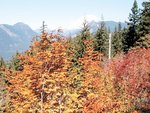


Fishing in the Cowlitz River reservoirs continues to be lackluster. A few anglers were fishing at Swofford Pond and the Mossyrock Dam and a few boats were out on Riffe Lake earlier this week, but fishing was mighty slow.
One angler reported catching a few nice 15-inch landlocked cohos from the dam the week before. The level of Riffe Lake is being lowered to late fall, early winter levels.
Fishing in Mayfield Lake was similar with a couple of people at the Mossyrock Trout Hatchery and a couple of boats out on the lake.
The water level is now back to normal for this time of year after the recent drawdown for the Ike Kinswa boat launch renovation work. This abnormal variation in the lake level most likely has disrupted the fish feeding patterns and water temperatures.
With traditional lakes in a temporary doldrums, you might want to consider a different fishing experience in a remarkable setting. You might want to try Packwood Lake this fall.
Fishing at this alpine jewel will continue until Oct. 31. The large (450-acre) lake is in the Goat Rocks Wilderness a few miles south of Packwood. The fish are all resident rainbow trout. There is a 10-inch minimum, five-fish daily limit and no bait is allowed.
Flies or lures with a single barbless hook are required. You may release uninjured fish until your limit is reached.
To get there, take Forest Road 1260, which turns south from U.S. Highway 12 on the east end of the town of Packwood next to the now-abandoned Packwood Ranger Station. The parking area for the two trails to the lake is six miles from the beginning of this two-lane, paved road.
There is a hiker or horse trail leading from the parking area and a motorbike, ORV and mountain bike trail that starts at a gated road just before you get to the parking lot.
Both of these trails are about 4½ miles long and since the lake is about the same elevation as the parking area, they are nearly flat. A Northwest Forest Pass is required at the parking area; contact the Cowlitz Valley Ranger District Office in Randle if you do not have one.
Fishing from the shores of Packwood Lake is possible, but a rubber boat or some sort of flotation device would be the preferred method. Remember that no motors are allowed on the lake because of the "wilderness" designation.
When we visited the lake earlier this week, the level was down about 6 or 8 feet from the high water line, so walking around the shoreline to fish would be easy.
Packwood Lake has a long history of fishing dating back to American Indian times. The earliest archaeological evidence of American Indian use occurred around 850 A.D. and continued until about 1900, when the "Big Bottom" lands of the upper Cowlitz River were settled.
The origins of the introduction of trout into the lake were recorded in oral histories of the Taidnapam, or Upper Cowlitz people, in the early 1900s. The Chehalis Bee-Nugget newspaper carried an article about it in 1909, as early settlers began frequenting the lake for recreation and the good fishing that could be found there.
American Indian fishing actually occurred in the streams flowing into the lake, rather than the lake itself. During late May until early July, tribal fishers would use small basket traps or weirs to catch the rainbow trout that entered these streams to spawn.
Due to its popularity as a recreation site, a tent resort was built at the lake in 1921 and operated under a Forest Service permit. Cabins later replaced the tents and a lodge was added in 1937. Eventually there were 13 cabins and about 30 boats for rent.
For 40 years or so, Ralph and Agnes Neely ran the resort, after having worked there for the original permittee. They left in the early 1980s and in 1991 the resort was closed and the three remaining cabins burned. The lodge burned down in 1979.
Packwood Lake is also home to a hydroelectric project currently owned and operated by Energy Northwest of Richland. It consists of a small dam on the lake outlet and a five-mile-long pipeline leading down to a powerhouse in Packwood.
Washington Public Power Supply System, the infamous "WHOOPS" —usually associated with the failed nuclear power plants around the state —originally constructed the Packwood Lake project in 1964.
As early as 1906, the local Valley Development Co. was investigating the hydroelectric potential of the lake. The Valley Development Co. constructed a cabin for workers near the outlet in 1910.
Later, the Forest Service used it as a guard station during the summer until a new building was constructed in the 1960s. During this past summer, the old log cabin, which was one of the oldest surviving buildings on the Gifford Pinchot National Forest, was restored by the Forest Heritage Program and volunteers including the White Pass High School Discovery Team.
The Discovery Team is a project that expands students' appreciation of community history, culture and natural resources while providing them with work experiences.
Although nothing has been decided so far, there is a possibility that the restored cabin will be made available to the public as a recreation rental to help recover part of the restoration cost.
Historic cabin rentals have been very popular and successful elsewhere on the forest. If you would like more information regarding historic cabin rentals, or to check on the future availability of the Packwood Lake Cabin, contact the Cowlitz Valley Ranger District.
Buddy Rose is a lifelong outdoor sportsman and resource professional in Lewis County. He brings an extensive background of experience and practical knowledge to his weekly writings in the "Outdoor" section. Rose can be reached at budlisarose@juno.com